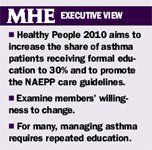Self-management techniques lacking among asthma patients
Just 8% of asthma patients recieve proper education, and insurance status is not the ultimate factor

Patient education is an obvious tool, even though programs aren't as widespread as one might think.
Currently, only about 8% of asthma patients receive formal patient education, according to the Centers for Disease Control and Prevention (CDC). What's more, insurance status isn't always a predictor. The CDC analysis found that adults with insurance were far more likely than uninsured adults to have had an asthma management plan at some point, been taught to monitor peak flow, taken a class on asthma management, and been taught how to respond to an asthma attack. Likewise, among young people, insurance was not associated with significant differences in asthma education.

During the personalized sessions patients received asthma information, information about reducing exposure to personally relevant allergens, a personal action plan and instruction in the correct use of their inhalers.
In the Netherlands, researchers are studying the Internet-based consultations as a way to help patients better control their symptoms day-to-day. Patients who received online help, in addition to standard care, showed greater improvements in symptom control over the course of a year and were more likely to report symptom-free days when compared with patients who received only standard care, according to results published in the Annals of Internal Medicine.
Outside of academic centers, insurers and disease management companies are looking for ways to make asthma information more readily available and relevant to patients. For example, Nurtur Health, a Farmington, Conn.-based disease and health management firm, is expanding a pilot program that stations asthma health coaches in select doctors' offices to work directly with physicians and patients. The company is likewise experimenting with texting as a way to link health coaches with asthmatic teens.
"We don't know if it will be successful or not," admits Judy Topolsky, Nurtur's client service director for respiratory accounts. "We're just looking at what communication tools are out there to see what works."
ENVIRONMENTAL FACTORS
APS Healthcare, which serves a large Medicaid population, recently shifted its outreach model from a telephonic model to one that incorporates additional face-to-face contact with patients. By placing health coaches in high-volume settings-such as emergency rooms, rural clinics, community mental health centers, and federally qualified health clinics-APS hopes to help patients with chronic diseases better manage their conditions. Its health coaches use these encounters as an opportunity to help patients develop action plans and understand the environmental factors that may exacerbate their asthma, explains Stephen Saunders, MD, the company's chief medical officer.
Insurers are likewise exploring ways to use financial incentives to motivate better self-management. APS sometimes uses store gift cards to reward Medicaid recipients who fill out health risk assessments, while Louisville-based Humana has tweaked its pharmacy benefits so that employers have an option of covering all asthma drugs at a generic copay rate.
Derek van Amerongen, MD, chief medical officer for Humana of Ohio, expects that during the next few years insurers will find still more ways "to help people see the connection between their actions and the direct financial benefit they receive."
For example, a plan member with asthma might receive additional services and benefits-such as a waived copay for physician visits-if he or she is compliant with certain self-management guidelines.
Important as all these outreach efforts and incentives may be, they can largely be described as ways to lead a horse to water.
"To really have an impact on asthma self-management, you must start with patients who have demonstrated that they are ready and willing to change," says Howard Zeitz, MD, an allergist and associate professor at the University of Illinois College of Medicine at Rockford. "You have to find the ones who are ready to change now, and in two years, you have to be there for the ones who will be ready to change then."
For many people, managing asthma is neither easy nor convenient. It's not just a question of filling the prescriptions and taking them as directed. It may include quitting smoking, convincing a loved one to quit smoking, getting rid of the family pet, removing the wall-to-wall carpeting in the home, etc.
Recognizing that not every asthma sufferer is willing to do what it takes to manage the condition, an the interdisciplinary team in Rockford has borrowed a play from the addiction handbook and focuses on individuals who have been prescreened for their readiness to change. Participants take part in weekly two-hour group sessions in which they learn more about asthma management, identify which behaviors they want to change and seek input and advice from peers.
Early results, which include improvements in frequency of peak flow monitoring as well as better quality of life and asthma knowledge, are promising, and a Virginia health plan is currently considering the program for use within its own organization. Still, Dr. Zeitz cautions, replicating those results will take commitment on the part of both asthma patients and the organizations that seek to help them.
"Changing behavior is not something you do in 10 minutes," he says. "Most self-management programs consist of a series of didactic lectures or a single seminar and then the patient disappears and never comes back. You're not going to change someone's behavior with one session."
Behavior change takes repetition. The education process applies best to people who are ready to change.
Shelly Reese is a freelance writer based in Cincinnati, Ohio.
Why Patient Registries Need to Make the Move From Tactical to Strategic Research Initiatives
September 6th 2022The one-sided, research-oriented approach has to change so patients have ready access to dashboards with their disease histories and pre-visit documents tailored to the patient questions.
Read More
Study: Patients with High Deductible Plans More Likely to Delay Care
September 7th 2021Patients faced with high out-of-pocket costs sometimes delay seeking care for appendicitis or diverticulitis, which can result in higher overall costs, increased risk of mortality, and a worse quality of life.
Read More